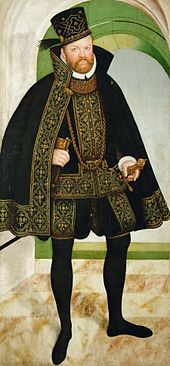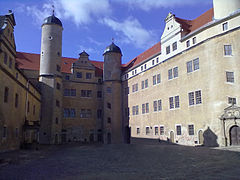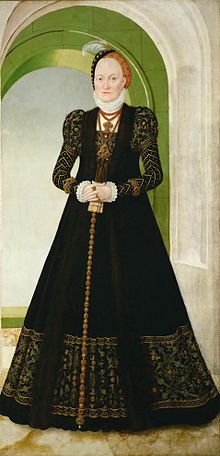August (Saxony)

August's signature:
August (born July 31, 1526 in Freiberg ; † February 11, 1586 in Dresden ), who called himself Augustus and, with reference to his paternal position, was popularly called Father August , was Elector of Saxony from 1553 until his death Albertine line of the House of Wettin . He succeeded his brother Moritz, who died without a male heir in the battle of Sievershausen , to the throne.
Life
youth

August was first educated by the Rochlitz pastor Martin Oberdörffer. He later grew up at the imperial court in Innsbruck , where he became a close friend of the future emperor Maximilian II , and was trained by the school reformer Johannes Rivius , among others . Unlike in the father's will, August initially did not receive any territories from his older brother Moritz, but only financial grants, and in 1544 he was given the management of the diocese of Merseburg .
On the occasion of his first marriage, August was given his own court in Dresden, with Wolkenstein Castle as a hunting and country residence. Moritz had entrusted his brother with the defense of Dresden as early as 1546 and given him his own troop command. In 1552 Moritz transferred the reign to his brother, who immediately sought an alliance with his father-in-law, the Danish king.
Elector of Saxony

After the death of his brother Moritz, August 1553 became Elector of Saxony. August's full title can be found in a Bible from 1576: "Augustus Duke of Saxony / of the Holy Roman Empire Archmarshal and Elector / Landgraff in Döringen / Marggraff in Meissen / and Burggraff in Magdeburg ".
August wisely expanded the territorial state created by Moritz politically and militarily, but in 1554 in the Naumburg Treaty he renounced a large part of his territory in favor of the Ernestine line of the Wettins . In addition to the offices of Altenburg , Eisenberg , Herbesleben and Sachsenburg , this included almost all of Thuringia . But August acquired domains worth more than 700,000 guilders by barter and purchase until 1567, which he combined to form new offices .
In 1555 August was elected Colonel of the Upper Saxon Imperial Circle . Under his rule, the diocese of Meißen was secularized and the monastery territory was integrated into the Saxon electoral state in 1559 ( Stolpen and Bischofswerda ) and 1581 ( Mügeln ).
During the so-called Grumbachian Handel in 1567, August was able to conquer Gotha, capture the outlawed Ernestine Johann Friedrich II , and in this way acquire several Thuringian offices.
The thaler for the capture of Gotha (1567) , which the elector had minted with a demonstratively large Kurschild after his victory, bears an inscription on the reverse about the execution of the empire commissioned by the emperor and carried out by August.
Through the guardianship of the children of Johann Wilhelm von Sachsen-Weimar and the profit of the Vogtland and part of the county of Henneberg , August posted further enormous territorial gains.
In the empire he was the leader of the Lutheran estates . August initiated and signed the concord formula of 1577 and the concord book of 1580 and, as guardian, also carried out the signatures for the dukes Friedrich Wilhelm I of Saxe-Weimar , Johann III. von Sachsen-Weimar , Johann Casimir von Sachsen-Coburg and Johann Ernst von Sachsen-Eisenach . Successfully he was concerned with a compromise with the Catholic emperors from the House of Habsburg , with whom he made a joint front against the Calvinists .
August died in Dresden in 1586 and was buried in Freiberg Cathedral .
meaning

AVGVSTVS D: G DVX SAXO SA ROMA IMP ( obverse ) and ARCHIMARS CHAL ET ELEC
Politics, economy, agriculture, finance
August was one of the few European princes who managed to save up an extensive state treasure in the 16th century . He owed this to the efforts of his chamber master Hans Harrer , even if he made massive speculations in the pepper trade to the detriment of the electoral casket and then committed suicide. Albertine Saxony experienced an economic and social boom under his government (1553–1586). Domestically, he tried to make himself largely independent of the Saxon estates . He expanded the sovereign administrative structures and reorganized the judiciary. In 1559 the Court of Appeal , based in Dresden, was created as a second instance. With the constitution of 1572 , the most extensive Saxon code of law to date was passed. The constitution had the character of the legislation on disputes. It was now available to every subject of the Electorate of Saxony, e.g. B. Bauern, free to turn to the appellate court in Dresden with the help of an attorney in civil court matters if one did not agree with the court judgment from the first instance.
In the course of his extensive reforms, he also reorganized the coinage system. The elector had all state coins closed and transferred them to a single coin in Dresden, in the immediate vicinity of his residence palace , in order to be able to better monitor the correctness of the shot and grain . The state main mint in Freiberg had to cease operations in 1556 despite protests from the Freiberg council. In 1557, the elector moved the Annaberg mint to the local monastery, before merging it with the Dresden mint in 1558. The Schneeberg mint was in operation until 1571. The elector closed the Leipzig mint , which had been inactive for a long time , in 1571. This made the Dresden Mint the only mint in the Electorate of Saxony.
August promoted agriculture and laid the foundation stone for the art and scientific collections of the Dresden court with the Kunstkammer, founded in 1560 . Scientifically educated, he was particularly interested in astronomy, cartography, mathematics, the art of measuring, and also collected astrological prophecies. To this end, he maintained various personal and correspondence contacts with scholars. The most important German bookbinder of the Renaissance, Jakob Krause, worked for him as court bookbinder from 1566 to 1586 . The catalog of the court library on the Annaburg contains 1,722 volumes. It is considered to be the oldest documented catalog of today's SLUB Dresden.
He put the management of the forests through the Forest and Wood Regulations of September 6, 1560, to make a profit. His forest officials also benefited from this order; they had a special financial interest in selling wood, leasing trees for resin , limiting the movement of cattle in the forests and using hatwood .
Client
Elector August was probably the most important builder of the Saxon Renaissance . There is evidence of his great interest in questions of construction and architecture . His library contained many architectural writings and sample books of building elements. His main work is the huge Augustusburg hunting lodge , built from 1568 to 1572. Nowhere in Europe has an ideal geometric plan been implemented so consistently. The design of the original model could go back to August itself.
He completed the expansion of the Dresden Residenzschloss (1553–1556) that his brother Moritz had begun. Since his passion was hunting, he had numerous official castles prepared for his hunting stays. Not only did he use the Moritzburg hunting lodge built by his brother , but immediately after his accession to the throne in 1554–57, he had Nossen Castle expanded into a hunting seat by building a new west wing and the Grillenburg hunting lodge built in 1554–58 in order to be able to hunt the crickets ( in the sense of worries). In 1556 he acquired the large Wermsdorf Forest as a court hunting ground (which was used as such until 1918 and where the electoral hunting castles of Wermsdorf and Hubertusburg were built under his successors ). 1555–58 he had Schwarzenberg Castle expanded into a hunting seat, and in 1569 he built the Jägerhof (Dresden) . He had the old Gommern Castle demolished and rebuilt as a hunting lodge in 1578. From 1572 to 1575 he had Annaburg Castle, named after his wife, built for her as a widow's residence and hunting lodge. He also had Lichtenburg Castle built for his wife in place of an earlier monastery . He also initiated the expansion of Dippoldiswalde Castle and Freudenstein Castle as official castles. The planned large-scale renovation of Osterstein Castle (Zwickau) only came about after August's death from 1587 to 1590. Its most important architect was the master builder Hans Irmisch .
Nossen Castle (west wing)
family
ancestors
| Pedigree of August of Saxony | ||||||||
|---|---|---|---|---|---|---|---|---|
| Great-great-grandparents |
Elector |
Duke |
Viktorin von Podiebrad (1403–1427) |
Smil von Sternberg (–1431) |
Duke |
Elector |
Wartislaw IX. (1400–1457) |
Duke |
| Great grandparents |
Elector Friedrich II. (1412–1464) |
King George of Podebrady (1420–1471) |
Duke Heinrich IV of Mecklenburg (1417–1477) |
Erich II von Pommern-Wolgast (1425–1474) |
||||
| Grandparents |
Duke Albrecht the Courageous (1443–1500) |
Duke Magnus II. (1441–1503) |
||||||
| parents |
Duke Heinrich the Pious (1473–1541) |
|||||||
|
August of Saxony |
||||||||
siblings
August was the third son of Duke Heinrich of Saxony (1473–1541) from his marriage to Katharina (1487–1561), daughter of Duke Magnus II of Mecklenburg . His older brother was the Saxon Elector Moritz, his sisters were Sibylle , Duchess of Saxony-Lauenburg since 1540 , Aemilia , Margravine of Brandenburg-Ansbach since 1533 , and Sidonie , his eldest sister, with whom he had a particularly close relationship throughout his life he supported her difficult marriage with Duke Erich II of Braunschweig . Another brother, Severinus , died as a child.
Marriages
In Torgau August married Anna (1532–1585), daughter of King Christian III on October 7, 1548 . from Denmark . Marriage - albeit politically arranged - was already considered harmonious and exemplary by contemporaries. The couple was separated only a few days during their 37-year marriage.
On January 3, 1586, three months after the death of his first wife, August married Agnes Hedwig von Anhalt , only 12 years old , daughter of Prince Joachim Ernst von Anhalt . He died six weeks after the wedding.
progeny
August had 15 children from his first marriage to Anna of Denmark and Norway (1532–1585):
- Johann Heinrich (* / † 1550), Elector Prince of Saxony
- Eleanor (1551–1553)
- Elisabeth (1552–1590)
- ⚭ 1570 Count Palatine Johann Kasimir von Simmern (1543–1592)
- Alexander (1554–1565), Prince Elector of Saxony
- Magnus (1555-1558)
- Joachim (* / † 1557)
- Hector (1558-1560)
- Christian I (1560–1591), Elector of Saxony
- ⚭ 1582 Princess Sophie of Brandenburg (1568–1622)
- Marie (1562–1566)
- Dorothea (1563–1587)
- ⚭ 1585 Duke Heinrich Julius of Braunschweig-Wolfenbüttel (1564–1613)
- Amalie (* / † 1565)
- Anna (1567-1613)
- ⚭ 1586 (closed 1593) Duke Johann Casimir of Saxe-Coburg (1564–1633)
- August (1569–1570)
- Adolf (1571–1572)
- Friedrich (1575–1577)
An illegitimate daughter:
- Katharina Sybilla (1584–1658), married to Friedrich von Mägendhoff in 1620.
literature
- August von Kluckhohn : August (Elector of Saxony) . In: Allgemeine Deutsche Biographie (ADB). Volume 1, Duncker & Humblot, Leipzig 1875, pp. 674-680.
- Hellmuth Rößler: August (Elector of Saxony). In: New German Biography (NDB). Volume 1, Duncker & Humblot, Berlin 1953, ISBN 3-428-00182-6 , pp. 448-450 ( digitized version ).
- Friedrich Wilhelm Bautz : August (Saxony). In: Biographisch-Bibliographisches Kirchenlexikon (BBKL). Volume 1, Bautz, Hamm 1975. 2nd, unchanged edition Hamm 1990, ISBN 3-88309-013-1 , Sp. 268.
- Reiner Groß : Elector August of Saxony - representative of early modern sovereignty in Electoral Saxony. In: Dresdner Hefte . Volume 9, 1986, ISSN 0863-2138 , pp. 2-12.
- Karl Czok : Elector August of Saxony. Sovereign and early capitalist entrepreneur. In: Sächsische Heimatblätter . Volume 33, No. 1, 1987, ISSN 0486-8234 , pp. 1-8.
- Karl Czok: Elector August I of Saxony (1526–1586). In: Rolf Straubel , Ulmann Weiß (ed.): Kaiser - König - Kardinal. German princes 1500–1800. Urania Verlag, Leipzig / Jena / Berlin 1991, ISBN 3-332-00386-0 , pp. 115-123.
- Jens Bruning: Country Father or Reich Politician? Elector August of Saxony and his regiment in Dresden 1553–1586. In: Manfred Hettling , Uwe Schirmer , Susanne Schötz (ed.): Figures and structures. Historical essays for Hartmut Zwahr on his 65th birthday. KG Saur Verlag, Munich 2002, ISBN 3-598-11585-7 , pp. 205-224.
- Jens Bruning: August (1553–1586). In: Frank-Lothar Kroll (ed.): The rulers of Saxony. Margraves, electors, kings. 1089-1918. Verlag CH Beck, Munich 2007, ISBN 3-406-54773-7 , pp. 110-125.
- Winfried Müller , Martina Schattkowsky , Dirk Syndram (eds.): Elector August of Saxony. A post-Reformation “Prince of Peace” between territory and empire. Contributions to the scientific conference from July 9 to 11, 2015 in Torgau and Dresden. Sandstein Verlag, Dresden 2017, ISBN 3-95498-302-8 .
- Ulrike Ludwig: Clairvoyant decisions. Elector August of Saxony (1526–1586) and geomancy as a strategy in everyday political business. In: Archives for cultural history. Volume 97, Issue 1, pp. 109-128.
Web links
- Literature from and about August in the catalog of the German National Library
- Works by and about August in the German Digital Library
- Jens Bruning: August . In: Institute for Saxon History and Folklore (Ed.): Saxon Biography .
- Tripota - Trier portrait database
- Musée national de la renaissance: The wire drawing bench of Elector August of Saxony
swell
- Bergk Order . Dreßden 1554, online edition of the Saxon State Library - State and University Library Dresden
- Forst- und Holtz = order of September 8th, 1560 . Online edition of the Saxon State Library - Dresden State and University Library
- The Elector of Saxony's tender for extremely low coins in 1568 . [Dreßden] 1568, online edition of the Saxon State Library - Dresden State and University Library
- The Elector to Sachssen, etc. competitions, Vorwarnunge, bid unnd Vorbot that Müntz anlangende, Anno 1569 . Dresden 1569, online edition of the Saxon State Library - Dresden State and University Library
- The Elector of Saxony, etc., repeated and in advance of writing, warning, serious command and foreboding, the Müntz approaching, Anno MDLXXI. April 8th . [Dresden] 1571, online edition of the Saxon State Library - Dresden State and University Library
- The Elector of Saxony and Burggraffen of Magdeburg etc. Letter of invitation, bid and advance bid, the Müntz arriving according to the contents of the H. Reich Müntzordnung and the farewells imposed on it . Dresden 1571, online edition of the Saxon State Library - Dresden State and University Library
- Mountain order of the most serene, high-born prince and lord, Mr. Augusten, moved to Saxony . Freyberg 1573, online edition of the Saxon State Library - Dresden State and University Library
- Nuptiis Illvstriss. et Potentiss. Pr. Ac Domini, Dn. Augusti Sac. Rome. Imperii… Ducis Saxoniae, Landgravii Thuringiae, Marchionis Misniae… II. Sponsi . Servestae 1586, online edition of the Saxon State Library - Dresden State and University Library
- Catalog of the library of Elector August on the Annaburg , online edition of the Saxon State Library - State and University Library Dresden
Individual evidence
- ↑ State rule and Reformation: Moritz von Sachsen und die ... Günther Wartenberg - 1988 - After Kreyssig, Martin Oberdörfer was an informator for Moritz and August from 1529 to 1535. This came from Rochlitz, in Leipzig SS 1510 imm. (Erler 1, 505, M 53: "Martinus Oberdorffer de Rochlicz")
- ↑ See BSLK , p. 15f and p. 762f.
-
↑ AUGUSTUS D [eo] G [ratias] DUX SAXO [niae] SA [crum] ROMA [num] IMP [erii] = August, by God's grace Duke of Saxony in the Holy Roman Empire,
ARCHIMARSHAL ET ELECT [or] = arch marshal and Elector ( back ) - ^ Karlheinz Blaschke : The Electoral Saxon Court of Appeal 1559-1835 and its archive. in: Journal of the Savigny Foundation for Legal History, Germ. Abt. 84, 1967, pp. 332f
- ↑ Alexander Kamcke: The importance of the peasant protection legislation of the Elector August (1555-1586) for the shaping of the peasant legal relationships in Saxony in the 16th century. Edelmann Verlag, Leipzig 1941, Diss., P. 5f
- ↑ Martina Schattkowsky : With the means of the law. Studies on conflict resolution in a Saxon manor. Tel Aviv yearbook for German history, Volume XXII, on the social and conceptual history of the Middle Ages, Tel Aviv University, Bleicher Verlag, Gerlingen 1993, ISBN 3-88350-496-3 , p. 299. Explanations on the appellate court and the patrimonial jurisdiction on a specific Example in Saxony
- ^ Catalog of the Electoral Saxon Library. In: Saxony.digital. Retrieved August 8, 2017 .
- ↑ Georg Victor Schmid: Handbook of all forest and hunting laws of the Kingdom of Saxony that have been published since 1560 up to the most recent time, Part 1, Meißen 1839, p. 3ff., Digitized in the Dresden State and University Library, accessed on April 13, 2014
| predecessor | Office | successor |
|---|---|---|
| Moritz |
Elector of Saxony 1553–1586 |
Christian I. |
| personal data | |
|---|---|
| SURNAME | August |
| BRIEF DESCRIPTION | Elector of Saxony |
| DATE OF BIRTH | July 31, 1526 |
| PLACE OF BIRTH | Freiberg |
| DATE OF DEATH | February 11, 1586 |
| Place of death | Dresden |







